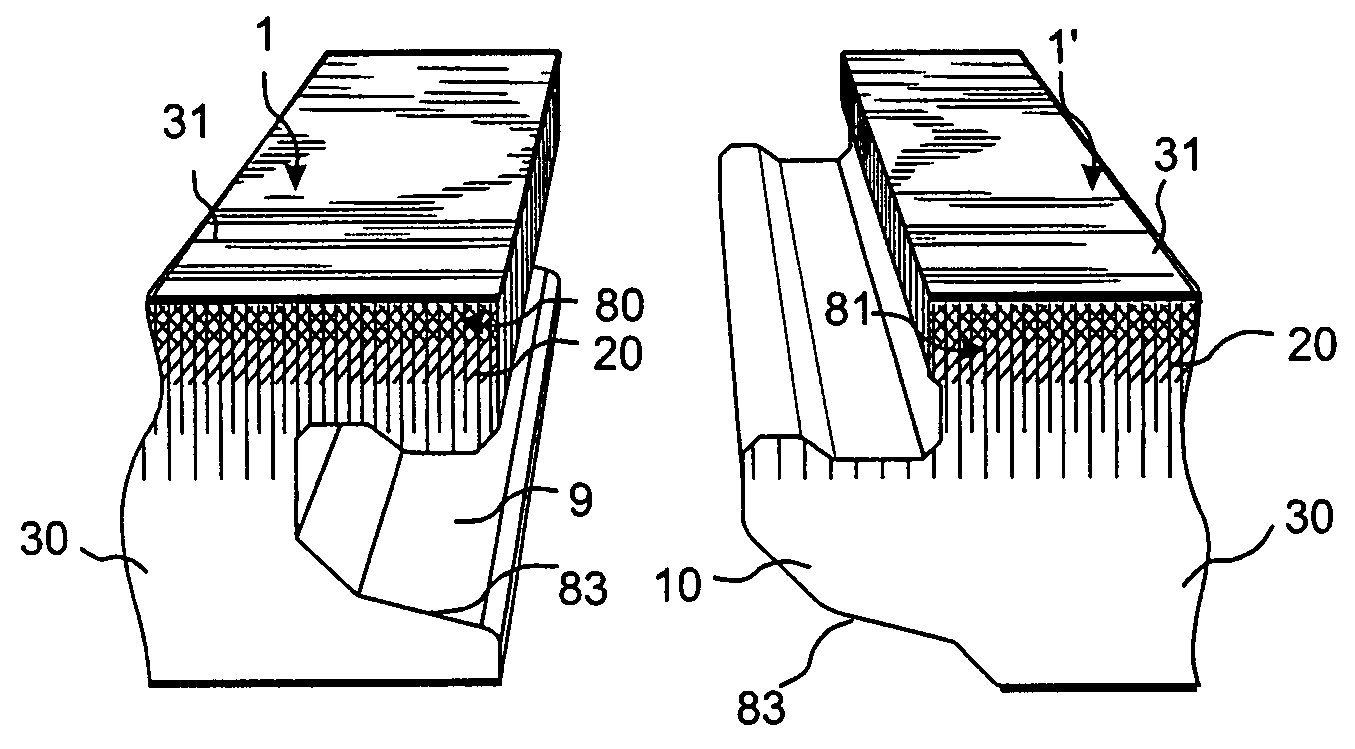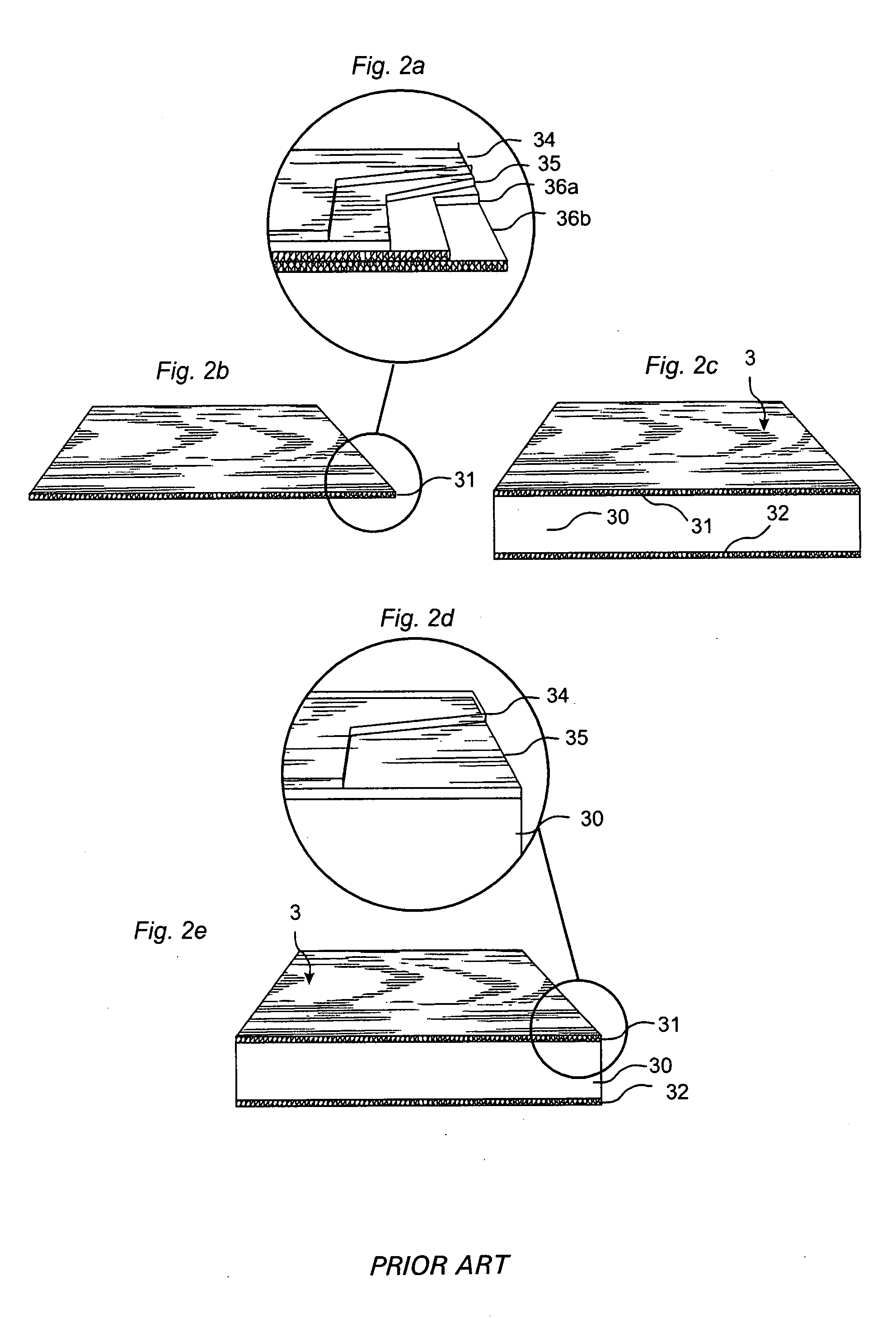[0047]The invention is based on the understanding that several types of seals may be involved for a moisture-proof locking
system for floor panels which can be joined together, viz. “material seal” which counteracts swelling of joint edges, “material seal” and “joint seal” which counteract swelling and
moisture penetration through the joint system, “compensation seal” which compensates for swelling and shrinkage of joint edges.
[0048]By “material seal” is meant a seal which prevents or counteracts spreading of moisture from the joint edge of a floor panel into the floor panel. By “joint seal” is meant a seal which prevents or counteracts migration of moisture through the joint along the joint surfaces. By “compensation seal” is meant a seal which adjusts to material movements caused by moisture in a floor panel (swelling and shrinkage) owing to changes of the moisture content, for instance by changes in
relative humidity in the
ambient air, and which counteracts stress under compression and the arising of a visible gap between the
upper joint edges of neighboring floor panels owing to such material movements caused by moisture.
[0050]Therefore an object of the present invention is to eliminate or significantly reduce one or more of the remaining problems associated with moisture sealing in connection with manufacture and use of floor panels. A further object of the invention is to provide a rational and cost-efficient manufacturing method for manufacturing floor panel cores, floorboard elements, floorboards and floor panels.
[0056]Thus, according to the first, second and third aspects of the invention, the core can be provided with inserted and fixedly secured elastically deformable materials, which may act as a sealing means and / or as compensation means for swelling or shrinking of the floor panels. The elastically deformable materials are applied in portions that will later will be machined for making the connecting means of the completed floor panel. The elastically deformable material will thus be machined simultaneously as or in connection with the
machining of the remaining parts of the joint system. As a result, the elastically deformable material can be made into accurately positioned and accurately dimensioned seals for forming the above-mentioned joint seals or compensation means.
[0059]By suitable methods, such as sawing or milling, the core can, before application of the
surface layer (for instance a decorative
surface layer), be pretreated so that, for instance, one or more grooves are formed in the surface in the areas where edge
machining of the joint system will later take place. Subsequently, a suitable sealing material is applied in the groove, suitably by impregnation or
extrusion or any other suitable method. The sealing material may form a material seal and / or may have the property of changing into a
solid, moisture-proof and elastically deformable material which could be formed to a joint seal. The
surface layer can then be applied to the surface of the core over the groove with the sealing material. According to this aspect of the invention, the sealing material can also be applied in a similar way after the application of the surface layer. The groove is then made in the floor element or the floorboard in the surface layer and in the core, or merely in the core of the floorboard. When the floor element is sawn up in floorboards, the edges will contain the sealing material. If the sealing material is applied in a groove or a machined edge part of the floorboard it is preferred that a
reference surface is machined in connection with the application of the sealing material. This
reference surface could be an outer portion of the edge of the floorboard. The final
machining of the locking system and the joint sealing could then be made in a second production step, where the
reference surface could be used to position the floorboard in relation to the machining tools. With this method it is possible to position sealing material with a tolerance of about 0.01 mm in relation to the joint surfaces, and the surface of the floor panel. It is possible to position and form a joint sealing in the core and in the lower part of a 0.1-0.5 mm thick surface layer. The joint sealing will protect the wood
fiber core and prevent moisture from penetrating trough the locking system. This method makes it possible to apply and form a seal in all types of laminate floors that could be produced with the sealing material. It is obvious that the method could be used for thicker surfaces of, for instance, 1-3 mm plastic and linoleum surfaces. Such a sealing will not be visible from the surface and it will protect the wood
fiber core under the moisture proof surface layer. If the sealing material is flexible, it may also prevent moisture from penetrating trough the locking system.
[0067]The material seal can consist of one or more materials which cover the entire core surface and which are also resilient and sound-reducing. The
advantage is that it is possible to obtain, at the same cost, a moisture seal, sound reduction and a softer floor. Parts of the joint seal may also constitute a material seal. Finally, the entire joint seal, or parts thereof, can also constitute a material seal. This means that the joint seal may also serve as a material seal with or without impregnation of the core.
 Login to View More
Login to View More  Login to View More
Login to View More 


